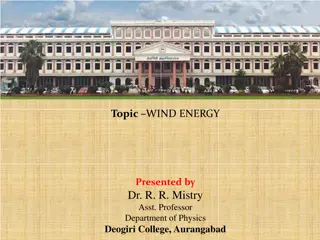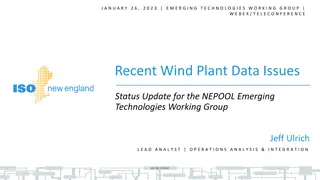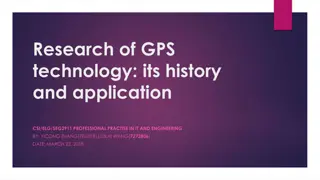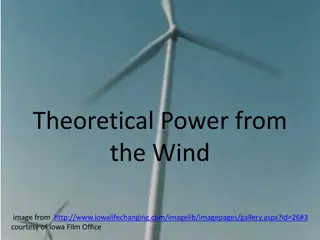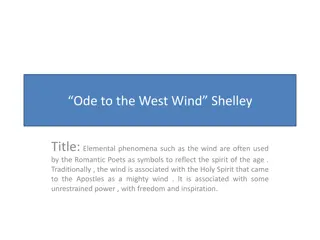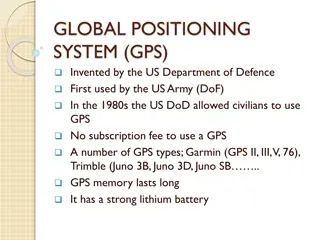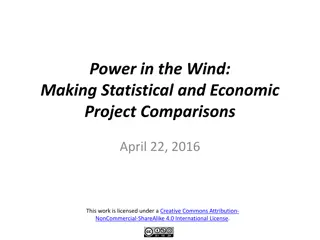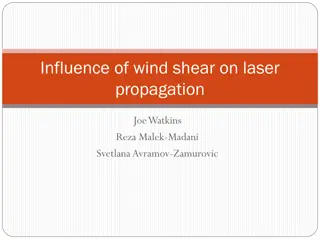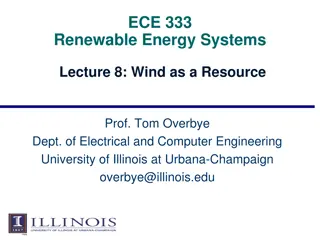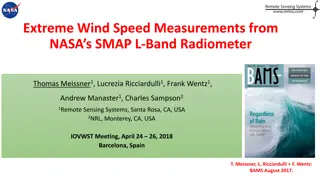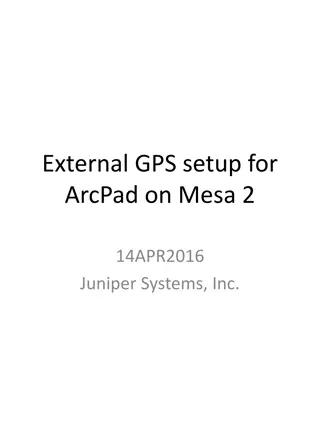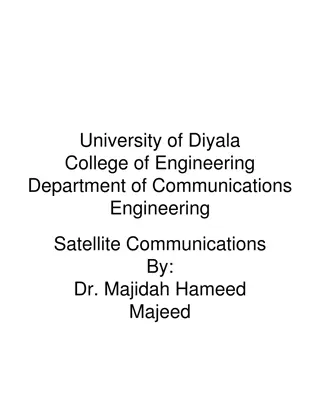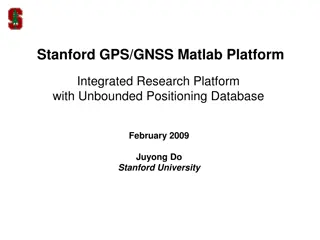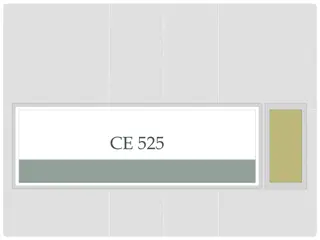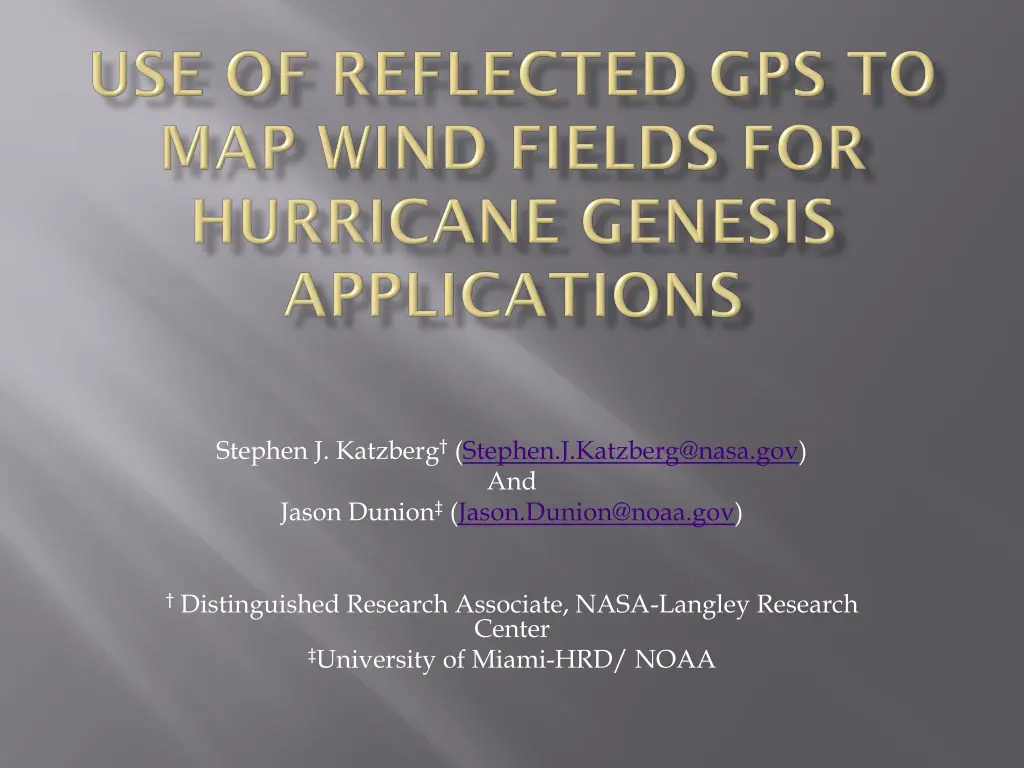
GPS Applications in Tropical Cyclone Research
Explore how GPS technology is used to study tropical disturbances, measuring ocean surface reflections and deriving wind speeds in atmospheric research. Learn about bi-static GPS configurations, calibration against models, and comparisons with dropsondes during hurricane experiments.
Download Presentation

Please find below an Image/Link to download the presentation.
The content on the website is provided AS IS for your information and personal use only. It may not be sold, licensed, or shared on other websites without obtaining consent from the author. If you encounter any issues during the download, it is possible that the publisher has removed the file from their server.
You are allowed to download the files provided on this website for personal or commercial use, subject to the condition that they are used lawfully. All files are the property of their respective owners.
The content on the website is provided AS IS for your information and personal use only. It may not be sold, licensed, or shared on other websites without obtaining consent from the author.
E N D
Presentation Transcript
Stephen J. Katzberg(Stephen.J.Katzberg@nasa.gov) And Jason Dunion (Jason.Dunion@noaa.gov) Distinguished Research Associate, NASA-Langley Research Center University of Miami-HRD/ NOAA
Very few aircraft measurements have been made in tropical disturbances over the past 25 years, largely because it is so difficult to collect data in these systems. -HRD IFEX05 description. THIS PRESENTATION WILL ILLUSTRATE BI-STATIC GPS APPLICATIONS TO TROPICAL CYCLOGENESIS.
The GPS Surface reflection technique is a configuration that uses GPS satellites as bi- static microwave illuminators Disturbances on the ocean surface give rise to scattering away from the specular point. Scattering away from the specular point represents additional signal delay and can be measured. The source of the scattering is non-zero surface slopes.
Calibration against COAMPS models Comparison with dropsondes at high wind speeds Katzberg, Stephen J., Omar Torres, and George Ganoe, Calibration of reflected GPS for tropical storm wind speed retrievals ; Geophys. Res. Lett., 33, L18602, doi:10.1029/2006GL026825, 2006 Katzberg, S. J., and J. Dunion , Comparison of reflected GPS wind speed retrievals with dropsondes in tropical cyclones, Geophys. Res. Lett., 36, L17602, doi:10.1029/2009GL039512., 2009
Even very low wind speeds generate non-zero ocean surface slopes, which can be detected in a bi-static configuration. Extensive GPS and dropsonde data were acquired during hurricane genesis experiments, such as IFEX 2005. These data sets have been compared for these flights to assess GPS retrieval accuracy at lower wind speeds.
Fit to ax+b With Outliers: slope 0.69, intercept 2.03 r.m.s: 1.3115 m/s Without Outliers: slope 0.88, intercept 1.21 r.m.s: 1.11 m/s
GPS derived winds compared to dropsondes from high altitude During circumnavigation of Hurricane Charley* *Altitude 13,000-14,000 m (39,000-42,000 ft.)
Cox and Munk showed that ocean surface slopes are dependent on wind direction. Scatterometers such as QuickSCAT make use of the anisotropy in backscattered power to determine wind direction. At L-band where GPS transmits, the relationship between anisotropy and an assumed skewed bivariate Gaussian like slope probability density has: A twice per azimuth angle variation and A weaker, once per azimuth angle component.
While there likely is a single-cycle-per- azimuth- rotation component, With the current receiver, only the dominant twice per azimuth cycle is extracted. This leaves, at least for now, a 180 ambiguity. In the illustration which follows, the Flight Level and Dropsonde wind directions have been repeated twice per cycle to account for this ambiguity.
The GPS bi-static technique has been shown to yield accurate low wind speeds. This GPS bi-static technique has been shown to be capable of determining wind direction, within a 180 ambiguity. Existence of a single cycle per azimuth rotation, yet to be demonstrated, can eliminate the ambiguity. The GPS technique can be used to reconstruct surface wind fields in weaker systems, including those undergoing tropical cyclogenesis.

